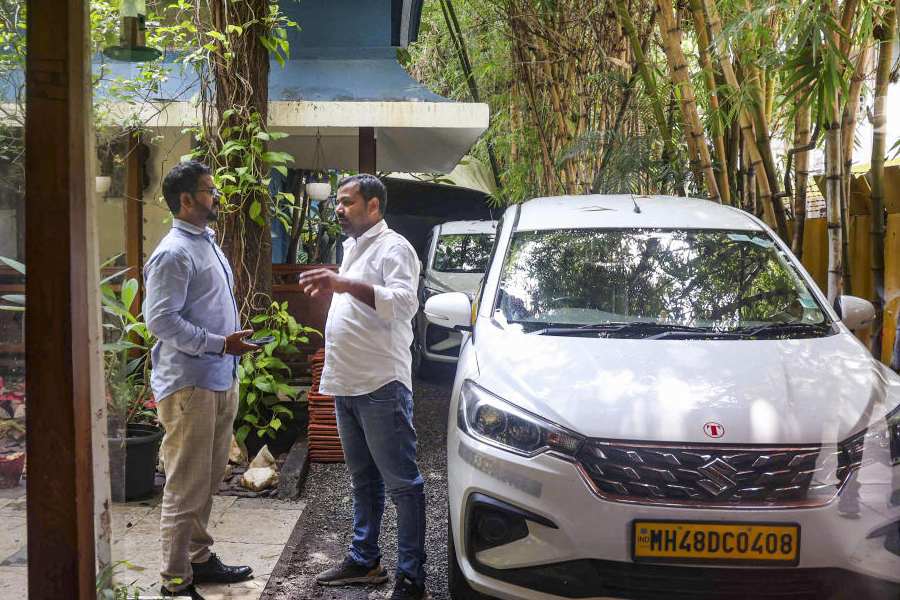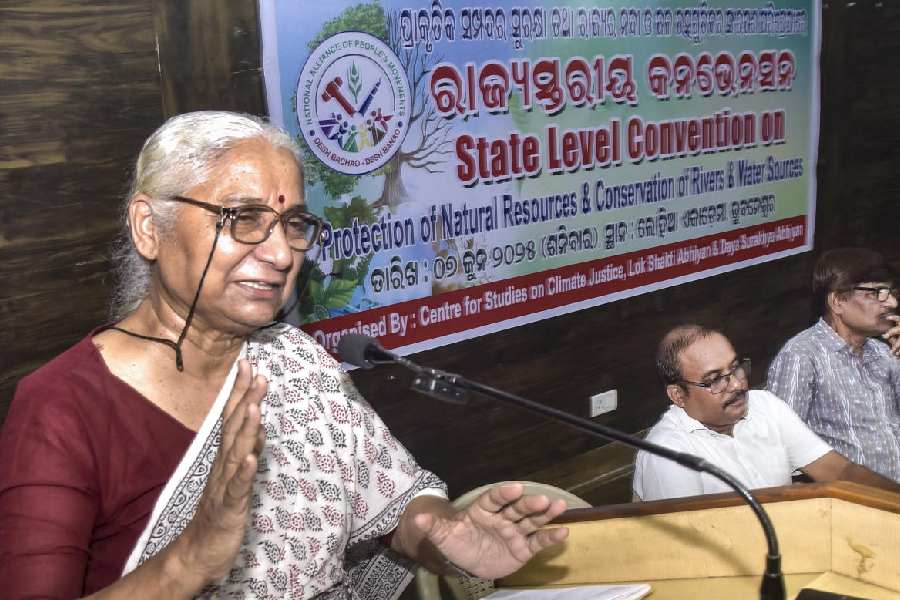 |
| EMPTY PROMISE? A project site in Rajarhat |
It was tom-tommed as the great hope of Bengal’s industrial resurgence. The Rs 15,000 crore Kolkata Link IT township at Rajarhat Newtown where information technology biggies like Infosys and Wipro would occupy pride of place and create upwards of 2.5 lakh jobs for Bengal’s youth. It was nothing short of a breathtaking vision of Bengal 2.0 and it made lots of industry majors come a-calling, keen to participate in this new IT hub of the East.
But earlier this week that vision seemed to have vapourised into thin air. The state government suddenly announced that it was ditching the entire project. Reason? Raj Modi, the man who was the government’s partner in the project and the prime mover in procuring land for the 1200-acre IT township, was put in jail for being involved in other, allegedly shady, land deals. And the Left Front government, caught in a series of political missteps ever since its dismal performance in the Lok Sabha elections in May this year, rushed to scrap the project, perhaps in a bid to distance itself from the tainted Modi.
Whether or not this was good politics is debatable. But clearly, the government’s decision has been a huge blow to the future of industry in Bengal. “There is no doubt that the decision of the government has come as a dampener to the state’s IT dream,” says Som Mittal, president, National Association of Software & Service Companies (Nasscom), which represents the software industry’s interests. “It was the IT industry that in a way gave a leg-up to the government’s efforts at industrialising Bengal. Now it is for them to decide what is good for the state.” Debesh Das, minister for information and technology, was not available for comment.
 |
The boom in Bengal’s IT sector has, in fact, been a major driving force behind the relative economic resurgence of the state that was notorious for industrial disputes till the 1990s. The state’s smokestack industries — engineering and jute — gradually shut down in the 1970s and 1980s. The IT industry could have sparked off a rejuvenation of the state’s industrial climate. That it did — but only to an extent.
Today, big ticket names like Tata Consultancy Services (TCS), Cognizant Technologies, IBM, Tech Mahindra and Siemens figure in the list of roughly 500 IT and IT-enabled services (ITeS) companies that operate in the state, mostly concentrated in Salt Lake’s Sector-V. Bengal’s software exports in 2008-2009 stood at around Rs 6,000 crore.
Yet that’s small beer compared with, say, Karnataka, which tops the list with Rs 74,929 crore for the same period. Unquestionably, the jobs potential that the IT industry offers is substantial — in Karnataka, it employed 540,000 people in 2008-2009, according to the the Karnataka government. In contrast, the industry employs some 50,000 people in Bengal.
Clearly, Bengal has a lot of catching up to do — something the government had wished to address when it came up with its proposed — and now abandoned — Kolkata Link project.
Yet the IT and IT-enabled services industry is wary about investing in Bengal. The head of a major BPO at Gurgaon on the capital’s outskirts cites several reasons for not setting up shop in Bengal. “There is huge high-end talent available, but the unionism is a big negative. The political pressures there are huge. This is all a function of a certain way of thinking. You can’t take business decisions independently there. We want to take decisions based on the merits of the case.” What is more, IT companies that are already here regularly complain of the state’s crumbling infrastructure. “This was supposed to be the dream destination of the IT sector. Now look at the potholed roads, waterlogging and the shanties. We are ashamed to invite foreign delegates during the daytime,” says S. Radhakrishnan, managing director Descon Limited and the vice chairman of Electronics and Computer Software Export Promotion Council, based in Salt Lake, Sector V.
IT CAMPUSES: THE STARS |
 |
| Infosys, Bangalore |
 |
| Google, San Francisco |
 |
| Apple HQ, California |
 |
| Wipro, Pune |
To be sure, several others say they would be willing to consider investing in Bengal, but would need compelling reasons — such as the availability of infrastructure, state government support and flexible state regulations — to choose Bengal over other states. Says Suparno Moitra, regional manager, Nasscom (East). “The infrastructure is quite poor compared with that in Hyderabad or Bangalore.” Another compelling reason to establish a presence in a state is the availability of land at low prices. IT companies demand big tracts of land. Wipro and Infosys, for instance, wanted as much as 90 acres of land each in the Kolkata Link township. But land prices in Calcutta are much higher than in, say, Hyderabad. Says Radhakrishnan, “Space for IT parks can be obtained for Rs 25-30 per square feet, versus nearly double that in Calcutta.”
Yet two questions beg for answers here. Why do IT companies want such a large amount of space? And should hugely profitable enterprises be granted land at low prices? “IT professionals are now used to sprawling campuses with facilities like swimming pools, tennis courts and food courts. This has become a global trend and the IT workforce in India expects to work in a similar environment,” replies Abrahim Ahmad, group editor, at IT magazine Dataquest.
Indeed, IT companies are spoilt for choice. “They have tasted blood. They are being inundated with offers to set up shop in so many states. So they are now looking for the best incentives,” Ahmad adds.
Mittal makes another point. “A minimum of 25 acres has to be acquired to earn Special Economic Zone (SEZ) status. Hence there is no question of companies like Wipro and Infosys going for areas smaller than that.” (SEZ units get a 15-year tax holiday on export profits).
It doesn’t help either that, as Nasscom’s Moitra points out, anybody who wants to set up shop in Bengal has to seek multiple clearances from government departments. If the IT department promises large tracts of land to companies, the housing minister refuses to help. (The Kolkata Link project fell partly under the Housing Infrastructure and Development Corporation land) In fact, housing minister Gautam Deb had offered 10 acres to Infosys and Wipro instead of the 90 acres they wanted. “Why don’t they develop multi-storeyed buildings or towers in 10 acres of land in the New Town area? They can easily go for vertical expansion,” he says.
Retorts Mittal, “It’s not about vertical and horizontal space, it is about an enabling environment. An office is not just a space for a software company like it may be the case in other sectors. It’s a place of innovation and ideas.”
Ctrl+Alt+Del |
| Why IT companies are leery of investing in Bengal |
● Trade unionism and a collective bargaining culture ● Poor infrastructure (potholed roads, waterlogging and so on) ● Relatively high land prices ● Multiple clearances from government departments |
As the debate rages, some neighbouring states are readying to cash in on Bengal's IT rumpus. “We have a stable and proactive government which offers a single window policy for the IT sector. Government departments work in harmony and land is not a problem here. I hope the companies that were thinking of investing in Bengal will move to our state,” says Ramesh Majhi, Orissa’s minister for information technology.
Yet all may not be completely lost to the state. Some IT companies have reiterated their commitment to Bengal. Says Kris Gopalakrishnan, CEO, Infosys, “Infosys has signed an MoU with the state government for our proposed project. When the business environment looks up, and if we receive an offer from the state government, we will take a re-look at the project.” TCS, which has a 40-acre plot in Rajarhat (outside the Kolkata Link IT township), also stresses that it “is not affected by the recent Rajarhat land issue.” Says a spokesperson, “We are going ahead with our plans for the upcoming campus.”
Around 15,000 people are expected to work at its Rajarhat campus.
And, who knows, perhaps the much vaunted — and now lamented — Kolkata Link township will also come to pass one day.










